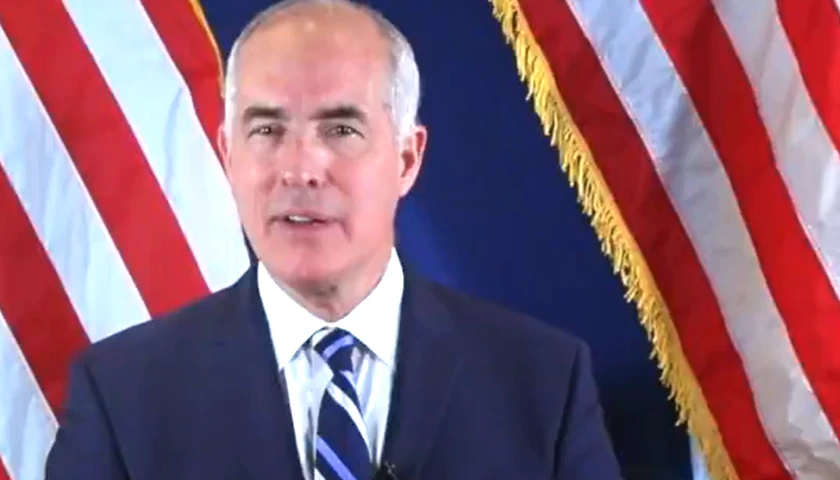by Luke Rosiak
Four years ago this month, then-Michigan Gov. Rick Snyder declared an emergency in Flint, and $390 million in state aid began pouring in. Much of the money, however, was spent on activities only peripherally related to lead in water, state spending data show.
About $129 million was spent on economic development and “social development,” nearly as much as the $144 million spent on safe drinking water, according to the state budget tally.
 Money from a state water grant was used to bring “a youth basketball league back to the city after a fifteen-year absence,” according to the book “The Poisoned City.”
Money from a state water grant was used to bring “a youth basketball league back to the city after a fifteen-year absence,” according to the book “The Poisoned City.”
State water-crisis money has been providing free daycare for children ages 3 and under in the city, even though none of them were alive or in utero during the primary water crisis, a state spokesman acknowledged. The city switched from the problematic water supply in October 2015.
Kurt Weiss, spokesman for Michigan’s budget office, told the Daily Caller News Foundation that the original justification for daycare was that staff could monitor kids who had been exposed to lead for signs of developmental delays.
“At some point you have to evaluate, at what point does the state say none of those kids were exposed to lead so you shouldn’t be running that daycare anymore? But the citizens of Flint still feel suspicious of government, as they should, so to pull funding for things that were put in place starts to become a difficult conversation,” he said.
Of $66 million that went toward economic development, $20 million went to Uptown Reinvestment Corp., a firm associated with four investors, two of whom are donors to Snyder, according to campaign finance records. Seven million dollars went to renovate an old building into new apartments, and $5.5 million to renovate the Capitol Theatre.
Under social development, the government also spent nearly $4 million providing extra money on the food stamp cards of residents, the state data show.
Some money under the “clean water” category itself was used to prop up general city activities, such as plowing snow and maintaining traffic lights, with the justification that it “support[ed] water distribution.”
The Flint Registry, which a federal grant supports, is paying residents $50 to fill out a form enrolling them, which in turn connects them to further services such as health screenings and education.
Flint Registry “THANK YOU” Check Increases to $50 for Completed Surveys in December and January
<!–
!function(d,l){"use strict";var e=!1,o=!1;if(l.querySelector)if(d.addEventListener)e=!0;if(d.wp=d.wp||{},!d.wp.receiveEmbedMessage)if(d.wp.receiveEmbedMessage=function(e){var t=e.data;if(t)if(t.secret||t.message||t.value)if(!/[^a-zA-Z0-9]/.test(t.secret)){var r,a,i,s,n,o=l.querySelectorAll('iframe[data-secret="'+t.secret+'"]'),c=l.querySelectorAll('blockquote[data-secret="'+t.secret+'"]');for(r=0;r<c.length;r++)c[r].style.display="none";for(r=0;r<o.length;r++)if(a=o[r],e.source===a.contentWindow){if(a.removeAttribute("style"),"height"===t.message){if(1e3<(i=parseInt(t.value,10)))i=1e3;else if(~~i<200)i=200;a.height=i}if("link"===t.message)if(s=l.createElement("a"),n=l.createElement("a"),s.href=a.getAttribute("src"),n.href=t.value,n.host===s.host)if(l.activeElement===a)d.top.location.href=t.value}}},e)d.addEventListener("message",d.wp.receiveEmbedMessage,!1),l.addEventListener("DOMContentLoaded",t,!1),d.addEventListener("load",t,!1);function t(){if(!o){o=!0;var e,t,r,a,i=-1!==navigator.appVersion.indexOf("MSIE 10"),s=!!navigator.userAgent.match(/Trident.*rv:11\./),n=l.querySelectorAll("iframe.wp-embedded-content");for(t=0;t
“The Flint Registry gives anyone exposed to Flint water from April 2014 until October 2015 — an estimated 150,000 people — access to services and programs,” the Flint Journal reported in 2019. “The Registry is funded in part by a $14.4-million grant from the U.S. Department of Health and Human Services.”
The registry increased the “thank you check” amount from $25 to $50 in December.
The registry is the brainchild of Dr. Mona Hanna-Attisha, director of the Pediatric Public Health Initiative at Flint’s Hurley Children’s Hospital. In her book “What the Eyes Don’t See,” she said the funds enabled “the stuff progressives dream about but never get.”
“Almost everything I asked for, my entire list of demands — all the wrap-around services for the kids that I had recommended — were, in some shape or form, in the budget,” she wrote of the funds allocated under Snyder.
Hanna-Attish wrote of her Flint advocacy as part of a lifelong struggle for social justice and quest to use government to right historic wrongs, referring to Flint’s past as “historic crimes and ethnic cleansing.”
“Republicans had starved the government and made the decisions that resulted in the water switch,” she wrote, adding: “If I had to locate an exact cause of the crisis, above all others, it would be the ideology of extreme austerity and ‘all government is bad government.’”
Even with funds available to enable what she called “awesomeness,” the vast majority of Flint residents have not completed the steps necessary for the registry to connect them with services.
“Over 12,500 have begun the enrollment process and 2,500 have fully enrolled in the Flint Registry. Of those who have fully enrolled, over 3,650 referrals have already been made to critical health and development services,” the registry said Dec. 2.
The Flint Registry did not return a request for comment.
Weiss said the economic and social funding is “the holistic part of the recovery.”
“When the Snyder administration was here and they sat down to formulate how do you go after the problem, one thing they focused on is the water crisis has really hurt the economy, businesses won’t be attracted to Flint, so how do we help that part of the crisis,” Weiss told the DCNF.
“Legislators from the Flint area continue to push for these resources. … Of course other cities around the state have their own infrastructure problems, so those cities start to say why does Flint get all the money,” he said. “And those conversations are going to have to play out during the budget process in the legislature.”
Ironically, the water crisis was precipitated in part by officials improperly tapping into a pool of money that was supposed to be for urgent environmental issues and using it for unrelated purposes.
In early 2014, local officials from Flint and nearby jurisdictions had wanted to build a new pipeline to get water from the Great Lakes because Detroit, which provided their water, was charging too much money.
They tried to pay for the project by manufacturing a “sham” environmental calamity: They said they needed emergency money for cleanup of a sludge lagoon, when in fact the vast majority was to pay for the new pipeline, prosecutors probing the origins of the water crisis later alleged.
Flint and Detroit cut ties before the new pipeline was completed. In April 2014, a hastily deployed stopgap — taking water from the nearby Flint River — resulted in lead leaching into the water because the city failed to add anti-corrosives.
A variety of local officials were involved in seeking the special environmental money, known as an “administrative consent order,” including city officials as well as emergency managers appointed by the state. The criminal charges were later dropped.
Water expert Marc Edwards — who flagged the toxic water and helped gain national attention early on — has said that Flint’s water has been back to normal for years, but that “there’s people with agendas who want to make a perception that the crisis is ongoing.”
City council finance chairman Eric Mays said on April 27, “We’ve taken in over $647 million. This is where the money is at,” adding that Flint “broke records for giving black folks money.”
Six million dollars went to resolving the immediate water problem by moving from the Flint River back to the Detroit source, and $25 million went to replacing lead water lines.
When replacing water lines, the city ignored maps that showed where lead pipes were, instead digging up the pipes in front of every house. The city paid engineering firm AECOM $6.1 million to supervise the digging of 12,000 sites, only 15% of which had lead pipes. Meanwhile, those who maps showed did have problematic pipes had to wait.
City officials also rescinded a contract from a company that was quickly making repairs and banned the use of “hydrovac” equipment, which digs up pipes cheaply and unobtrusively. That steered more work to a politically favored but inexperienced construction firm owned by an NBA player, which dug up yards using backhoes.
– – –
Luke Rosiak is a reporter for the Daily Caller News Foundation.




